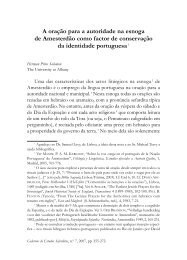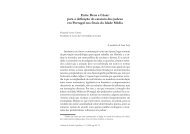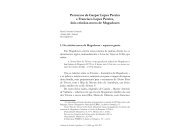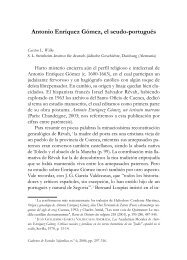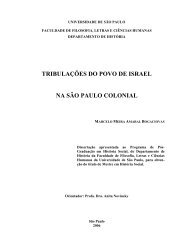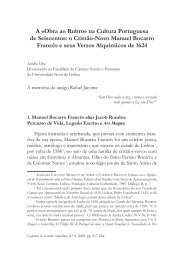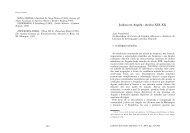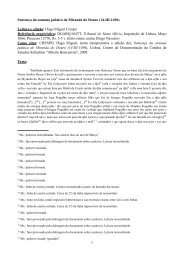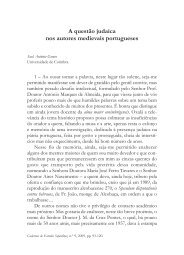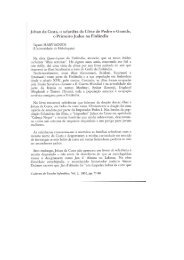Pagina 1-28.qxd - Cátedra de Estudos Sefarditas "Alberto Benveniste"
Pagina 1-28.qxd - Cátedra de Estudos Sefarditas "Alberto Benveniste"
Pagina 1-28.qxd - Cátedra de Estudos Sefarditas "Alberto Benveniste"
Create successful ePaper yourself
Turn your PDF publications into a flip-book with our unique Google optimized e-Paper software.
Pag 33-62:<strong>Pagina</strong> 1-<strong>28.qxd</strong> 10-12-2009 01:13 Page 38<br />
FRançOIS SOyeR<br />
remained a sizeable group of Castilian conversos still residing in Portugal<br />
in 1496, in<strong>de</strong>ed at least 150 households (casas).<br />
the measures implemented by João II had presumably successfully<br />
managed to expel a large number, possibly even most, of the<br />
Castilian conversos but the King had allowed this substantial minority<br />
to remain because of a papal absolution they had received from<br />
Rome. additionally, the effectiveness of the measures taken by<br />
João II to prevent the arrival of further fugitive conversos into Portugal<br />
is open to question. a document preserved in Seville, for example,<br />
informs us that on 13 november 1493 a conversa named Juana<br />
Diaz, who had fled from the tribunal of the Holy Office in Seville<br />
to seek refuge in the town of Faro in the algarve, took steps to<br />
have her daughter Isabel brought from andalucía to the safety of<br />
Por tugal. It is interesting to note that Juana Diaz un<strong>de</strong>rtook to<br />
bring her daughter to Faro in spite of the royal edict promulgated<br />
by João II in July of that very same year, which expressly forba<strong>de</strong><br />
the entry of more conversos into Portugal. 9<br />
Practically nothing is known about these exiled Castilian conversos<br />
during the first years of Manuel’s reign. the royal biographer<br />
Damião <strong>de</strong> góis, like all other Portuguese narrative sources, does<br />
not mention Castilian conversos at all. a rare indirect mention of<br />
Castilian conversos in Portugal does appear in a pardon granted by<br />
Manuel I to a certain Simão álvares of Monforte in May 1496. this<br />
man had escaped from the prison, where he had been imprisoned<br />
for the particularly grave crime of forging the King’s signature on a<br />
do cument. the document states that Simão álvares received his<br />
royal pardon in recognition of the unspecified assistance which he<br />
had provi<strong>de</strong>d in the apprehension, in Évora, of Jacob, his wife<br />
Jamila and their daughter Cimfa by the Crown’s officials Fernão<br />
lopes <strong>de</strong> Carvalho and Rui Dias – respectively juiz and alcai<strong>de</strong> pe -<br />
queno of Évora – in February 1496. according to the pardon, these<br />
9 J. gIl, Los conversos y la Inquisición Sevillana (Seville, 2000), Vol. 1, 105.<br />
38



